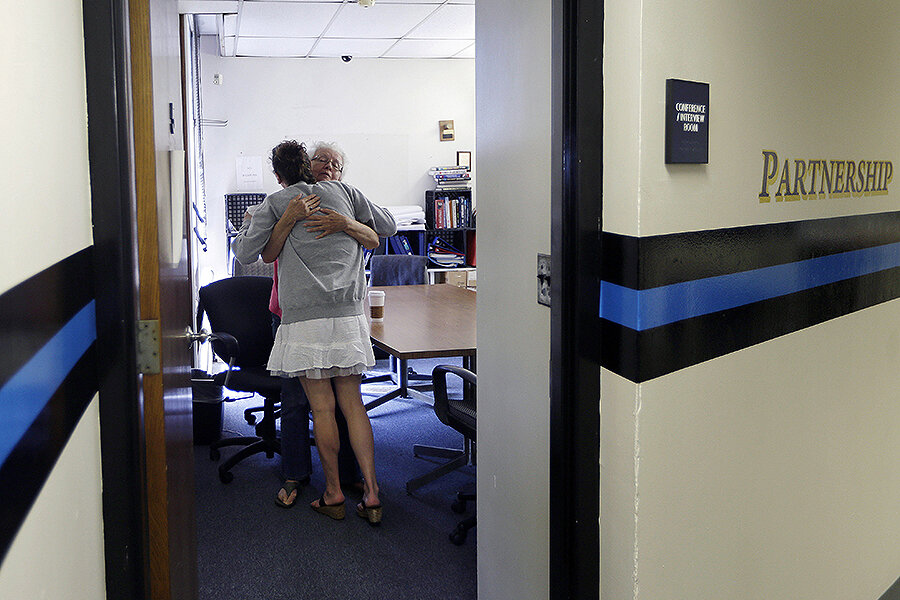Could 'safe rooms' for heroin users save lives?
Loading...
Since the 1600s, Boston has been the unofficial capital of New England — and, at times, the nation. Now healthcare advocates for the homeless believe it's time for the City on a Hill to lead the way in combatting a new scourge making alarming inroads in even small-town America: opiate addiction.
The Boston Health Care for the Homeless Program, which treats almost half of the city's roughly 25,000 people who are homeless for some point each year, is raising funds for a "safe space" for drug users: simply a room where they can receive medical attention, and rest in comfort, while they're high, as local NPR station WBUR reports.
Patients would not be allowed to inject or ingest drugs at the center, and workers would encourage them to seek treatment.
Today, nine countries host supervised injection facilities, where patients can use drugs, as opposed to just staying safe while they come down from a high. The nearest is in Vancouver, Canada, where it appears to have reduced overdose deaths, but not overall drug activity.
But advocates say even a simple "safe space" with medical professionals can save lives, and is worth the estimated $250,000 price tag.
According to BHCHP, heroin overdoses kill more homeless Bostonians than anything else, usually because they're far from care when they most need it. Social stigma and drug laws can discourage people from seeking help, if they even know where to look for it.
In 2014, more than 1,000 people died from opiates such as heroin in Massachusetts, a state of less than 7 million. For many, the journey to addiction began with prescription pain killers.
A new "epidemic" in heroin use has been well-documented nationwide, and frightened suburban families have realized that what they once considered a strictly inner-city drug problem can just as easily slip into their children's lives, often through the medicine cabinet. According to the Substance Abuse and Mental Health Services Administration, the number heroin users doubled between 2007 and 2012, many of them young adults and teens.
Since the problem became a regular headline-maker, debate has swirled about doctors' own accountability in prescribing so many painkilling pills that closely resemble the effects of heroin, and too often lead to its use.
But the problem is also worsened by the dramatic increase in drugs' potency. As the Christian Science Monitor has reported, purer heroin contributes to the problem in ways beyond the obvious: it's easier to get the same hit by snorting or smoking, letting new users avoid thinking of themselves as "junkies" whom they picture injecting the drug.
New England has been hard-hit, and towns like Gloucester, Mass., which has fewer than 30,000 residents, are experimenting with 'amnesty' programs that focus on healing, rather than punishment. BHCHP's chief medical officer, Dr. Jessie Gaeta, told WBUR that the proposed site of Boston's safe space feels like "the epicenter of opiate overdose" in the city; it's known as Methadone Mile.
Some critics feel that safe spaces and injection sites go too far towards forgiveness, and enable people who might otherwise be persuaded to quit. Others point out that a whole array of educational, treatment, and prevention options are needed. A room with nurses, juice, and a phone line is not a one-stop solution, critics say.
Others say they're the first step to future progress. "It’s not that we don’t want people to be drug free, but dead people don’t recover," Barbara Herbert, the president of the state branch of the American Society of Addiction Medicine, told WBUR.
Increasingly, medical researchers view addiction as a disease, and advocate for treating addicts with the same compassion and solutions-minded attitude as they would anyone suffering from a health problem.
Too often, doctors "kick people out of treatment for having symptoms of their disease with addiction, which would honestly be malpractice if we did that with other conditions," Dr. Sarah Wakeman told WBUR reporter Martha Bebinger.
But one consequence of that view – that addiction is best treated as a chronic condition – troubles those who say services like safe rooms encourage users to manage their drug use, rather than quit it.
Boston may yet prove to be a lab for drug-addiction specialists determined to find whatever works, whether it's safe spaces or something else.
"I’m up for trying anything when it comes to addiction and active using," Boston's Mayor Marty Walsh, who overcame earlier years of alcohol addiction, said to WBUR.








